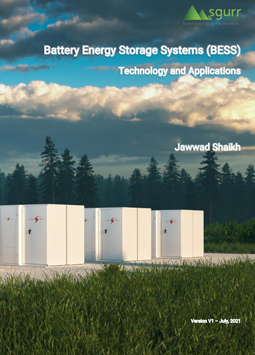
Jawwad Shaikh
jawwad.shaikh@sgurrenergy.com
Collecting energy produced at a specific time interval to consume at pre-defined time periods is known as energy storageand its corresponding system, Energy Storage System (ESS); although the term is analogous to batteriesor a Battery Energy Storage System (BESS), the definition can be used to understand the objective of batteries.
Energy storage also involves energy conversion from an electrical power source to a physical form, such as thermal, gravitational, or chemical energy, which is further converted to electrical energy for consumption, again, at pre-defined time periods.
Download to read the complete article.
Importance of Eccentric Wind Loading on Monopitch Module Mounting Structures
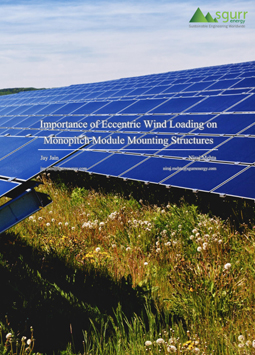
Jay Jain
jay.jain@sgurrenergy.com
Niraj Mehta
niraj.mehta@sgurrenergy.com
Wind load governs the design of the mounting structures of solar panels which constitute approximately 10 to 15 percent of the total project cost.
Wind load design of the ground-mounted photovoltaic (PV) power plants requires interpretation of the design code considering the particularities of these structures. Structural failures of utility scale PV plants are rare events, but some failures have still been observed in code-compliant structures.
Download to read the complete article.
Power Plant Controller
Putting the Power back Into the hands of the Developer
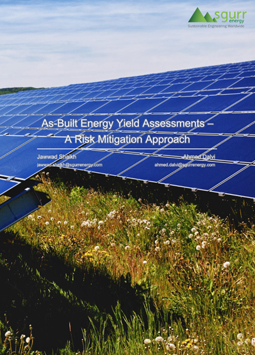
Dhiraj Madje
dhiraj.madje@sgurrenergy.com
The solar PV and Wind plants are assets which needs to consistently produce power with maximum control and predictability. This dynamic control of grid parameters is necessary in accordance with government guidelines which can be achieved using a power plant controller.
The Power Plant Controller (PPC) controls individual inverters to maintain specified active power, reactive power, voltage, power factor and frequency at the Point of Interconnection (POI). Most of the grid codes worldwide mandate use of PPC for any renewable plant over 10 MW in capacity.
Download to read the complete article.
As-Built Energy Yield Assessments
A Risk Mitigation Approach
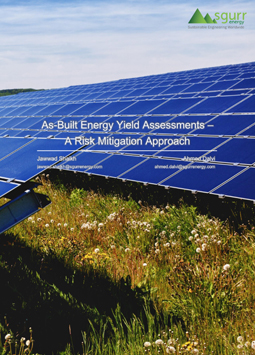
Jawwad Shaikh
jawwad.shaikh@sgurrenergy.com
Ahmed Dalvi
ahmed.dalvi@sgurrenergy.com
With solar PV having emerged as the leading technology in the renewable energy sector, with over 480GW global installations, the need for continual development and advancement in the methodologies for assessing the long-term profitability of the technology play a crucial role in the progress of the industry.
One of the primary mechanisms adopted to ensure the same is through accurately predicting the power generation of a solar power plant through detail oriented energy yield estimations.
Download to read the complete article.
Adoption of Bi-facial modules
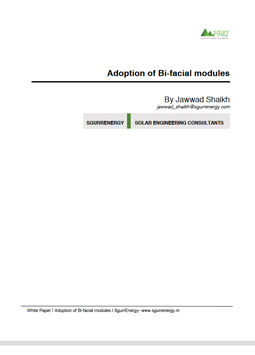
Jawwad Shaikh
jawwad.shaikh@sgurrenergy.com
Bifacial PV module technology has seen a steep increase in interest from the industry on the back of similar success of PERC technology enabled PV modules.
The technology however has been around for some time, with commercial production in place for over a decade. So how are the conditions different now from a few years ago? What is driving this widespread adoption of bifacial PV modules in the present time?
Download to read the complete article.
Flood risk assessment for utility scale solar PV plants
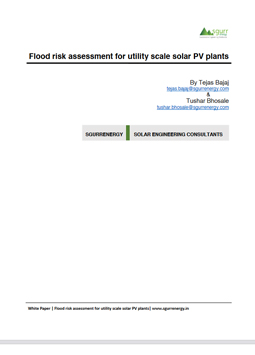
Tejas Bajaj
tejas.bajaj@sgurrenergy.com
Tushar Bhosale
tushar.bhosale@sgurrenergy.com
No one can control floods, but yes, it is possible to control the damage to solar PV plants due to them. The destruction of solar PV plant components largely depends upon the flood volume, velocity, duration and depth.
To avoid all such situations, it may be essential to conduct an in-depth hydrology study during the project planning stage, as we believe in ‘Prevention is better than Cure’.
Download to read the complete article.
Solar PV Projects
The Case for Independent Construction Monitoring
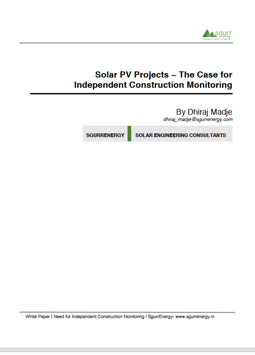
Dhiraj Madje
dhiraj_madje@sgurrenergy.com
A solar PV project is divided into various essential aspects of infrastructure such as: electrical engineering, civil engineering, module mounting structures, weather monitoring stations, and supervisory controls.
In order for a solar power plant to achieve the desired generation values, it is vital that the design conceptualization translates into implementation on the ground. This means that every aspect of engineering and construction needs to be properly validated, documented, and easily accessible during the project cycle.
Download to read the complete article.
Tracking Systems improve the economics of certain solar projects
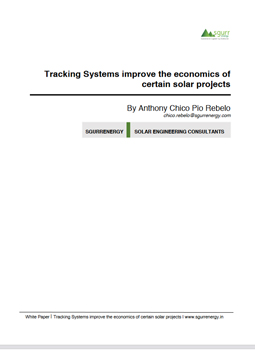
Anthony Chico Pio Rebelo
chico.rebelo@sgurrenergy.com
Developers face a number of challenges when creating proposals for solar projects and with the recent cancellation of power purchase agreements (PPAs) awarded to recognised developers, none of these challenges is more relevant in today’s market than the availability and acquisition of land.
This consequently leads to the question of whether to employ a fixed-tilt (FT) system or a horizontal single axis tracker (HSAT) system to achieve desired energy targets.
Download to read the complete article.
Floating solar system
A case for String inverters
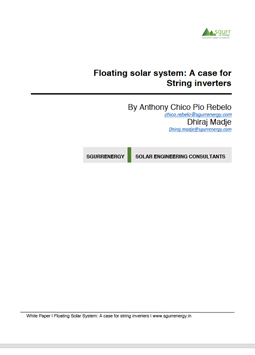
Anthony Chico Pio Rebelo
chico.rebelo@sgurrenergy.com
Dhiraj Madje
dhiraj.madje@sgurrenergy.com
Utility scale Solar PV projects is gaining global acceptance and its growth attaining an almost exponential trend, new challenges are emerging in the ever competitive landscape. Floating solar, also known as floatovoltaics is one of the emerging avenues for deployment of PV systems.
This technical article addresses the advantages and the essential challenges associated with implementing such systems, along with solutions adopted by developers.
Download to read the complete article.



